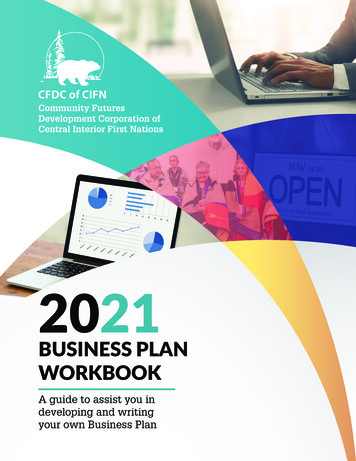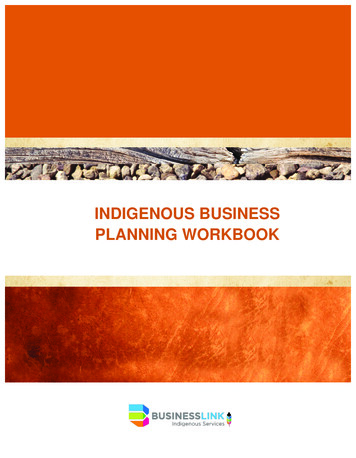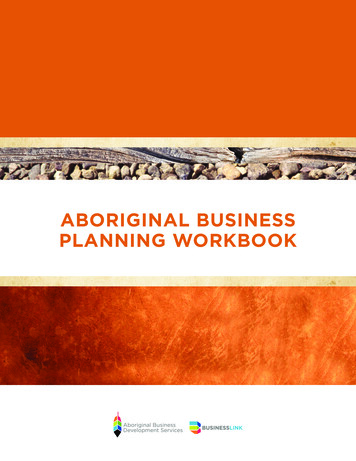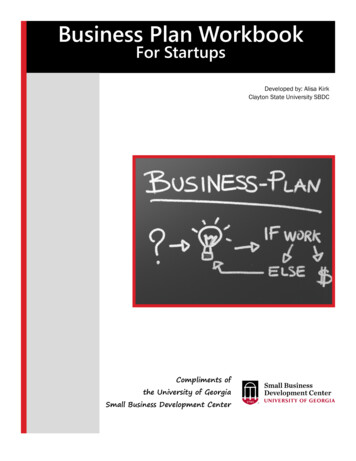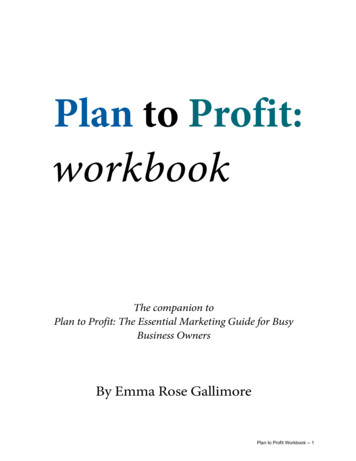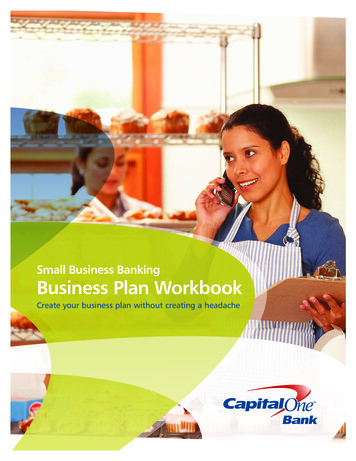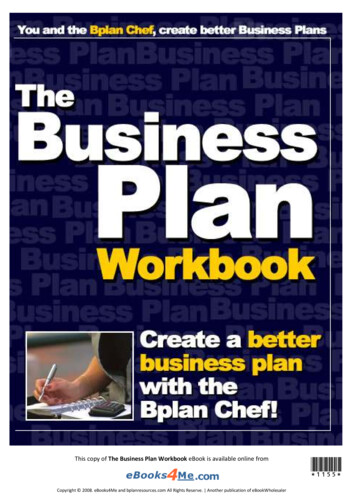
Transcription
This copy of The Business Plan Workbook eBook is available online from*1155*Copyright 2008. eBooks4Me and bplanresources.com All Rights Reserve. Another publication of eBookWholesaler
The Business Plan Workbook eBookThe Business Plan WorkbookCreate a better Business Plan with the Business Plan Chef!Table of Contents-IntroductionPages 3 to 4How to read this eBookPage 56 Reasons why you need to write a Business PlanPage 6Checklist for completing the workbook exercisesPage 7Business Plan ResearchPages 8 to 9Business Plan OutlinePages 10 to 13Executive summaryPages 14 to 15Company profilePages 16 to 18Marketing planPages 19 to 35Operational planPages 36 to 40Human ResourcesPages 41 to 42Financial PlanPages 43 to 46ConclusionPages 47 to 48AppendixPages 49 to 882
The Business Plan Workbook eBookTo Your Success!A Business Plan is crucial to the success of any business. An effective business plan is defined as follows:A formal statement of a set of business goals, the reasons whythey are believed attainable, and the plan for reaching those goals.We would like you to approach the entire Business Plan creation process with a positive mentality,eagerness to learn as well as with a dash of excitement!A wise individual once stated “If you fail to plan, you plan to fail.” We are of the opinion that anyone canprepare a cohesive business plan. Just as the gourmet chef assembles the key ingredients to insure asuccessful dish to delight the palate, so can you follow the guidelines of Bplan Chef in this workbook!This Workbook contains extensive guidelines, structure and template for working through thecomponents of a business plan, and to ultimately create a successful business plan.It is aimed squarely at new and established businesses seeking to expand, raise finance etc., which needto produce a comprehensive business plan for internal/external use. The Workbook is intended as anexercise book for sophisticated entrepreneurs as well as for small, medium and large businesses.The writing and thinking through your business requirements are as important as the final business plandocument. The Workbook allows you to challenge your assumptions, and produce a rough format withwhich to guide the creation of your business plan. You must use the notes from this workbook as areference for when you create your formal business plan.Follow through the business plan outline questions and write your responses on a separate piece ofpaper. Our purpose is to communicate to you the keys to developing a Business Plan and urge you totake ownership of your work. Use your own style. It should be a personal expression (an art form) asmuch as a professional document (scientifically and structurally sound).The objective of this workbook is to educate you on the following: Why you need a business planTo understand what a business plan entailsTo challenge your ideas and format them for presentationWhere and how to startHow to write an effective business planHow to ultimately use a business plan to develop your ventureHow to introduce and sell your venture to investors, financiersHow to introduce your products and services to your target marketBusiness planning does not just entail creating a report. It is in actual fact an exercise, an evolvingdocument that should guide you and you the operation of your venture. It communicates to investorsand other key parties, the status of your business and its road map for development, and success.3
The Business Plan Workbook eBookTo Your Success! (continues)A Business Plan should be a dynamic plan with its own personality and potential, and not just a carboncopy of another business. Ensure that your Business Plan truly reflects the uniqueness of the businessand your strategy to success.We are also of the opinion that you should build an element of “giving” in the operation of yourventures. Make a commitment right from the start to share a set percentage of your business successwith charities and other not-for-profit organisations of your choice. Manage your business not just tocreate wealth for yourself and your shareholders, but also to make a difference in the communities youoperate your business from.Enjoy the process. To your Success!The Bplan ChefJanuary 20084
The Business Plan Workbook eBookHow to read this eBookWe recommend that you print the Business Plan Workbook in order to make notes more easily.It is very easy to read and roam through your new electronic book via your computer. This eBook is onlyavailable in Adobe’s Portable Document Format (PDF). To read PDF documents one needs to haveAcrobat Reader installed.The latest version of the Adobe Acrobat Reader can always be downloaded free of charge t the bottom or top of each page of your PDF book in Adobe Reader, there is a box that shows thenumber of the page you are looking at and the total number of pages in your book. If you click on thenumber shown, a small box pops up. Type the number of the page that you want to go to into the box,press ENTER and you are there. Alternatively, you can type the number of the page you want to go toover the number shown in the small permanent box in the bottom task-bar of Adobe Reader, then justpress "Enter" and you go there.On the left of the box that shows the page number there are back and forward arrow button. Use thesebuttons to move the previous or next page.At the right side of your screen, there is a Scroll Bar to be used by you to manually scroll through theeBook. Adobe Reader also has an option for automatic scrolling through your pages. Just hitSHIFT CTRL H on your keyboard to activate this function, and ESCAPE to deactivate it.Watch out for the following symbols used throughout the Workbook:!Take note of critical guidelinesQInteresting quotes from interesting people5
The Business Plan Workbook eBook6 Reasons why you need to write a Business Plan1 - To Plot the courseDefine and Realize “what business am I in?” To create the “big picture” - to recognize long termdirection and think about staying in business and not just starting a business.2 – To Create a Feasibility Study Test the viability of your ideaIs it going to be profitableWhat kind of financing will you needRecognize the barriers to your success.3 - Become a Better Decision Maker Anticipate problemsThe process of gathering information ahead of time will allow you to make more informeddecisionsYour plan will provide you with an organized way to face issues.4 - For a Reality Check The plan will challenge some of your preconceived assumptionsYour plan will raise questions that will inspire solutions before you need face those problemsIt allows you to recognize what will be required of youIdentifies your strengths and weaknesses and highlights needed areas of assistance.5 - Guide & Measurement Tool The Business Plan will act as guide throughout your development and allow you measureyour progress against planned expectations. You can make adjustments accordingly.6 - Selling Tool The Business Plan is the document ultimately needed to sell your venture as an investmentopportunity to potential investors and partners (see www.postidea.com) and to your ownsuppliers, and employees.6
The Business Plan Workbook eBookChecklist for completing the workbook exercises The Business Plan’s audience. Who are you writing the Business Plan for? Obtain an idea of the type of structure you will need to create. This Workbook provides a fewexamples of Business Plans Prepare a timeline (how much time you will commit to the project and the completion date) Define the potential audience for you business plan (investors, suppliers, or employees), and whatthis plan provides for them; Gather research on your industry, on similar businesses, your particular location, type of business,sector, market, etc. Organize the research into easily referenced sections Write the planooooo!Use clear vocabulary, appropriate for your audienceAvoid unneeded jargonNote to stress your plan is of quality and not just quantityBe confident, it will show in your writing styleHow are you able to make it happen - make a strong case for your competency to lead thebusiness (investors place their money and confidence in “YOU” to make it happen, not justinvestment into an idea)By taking the time to go through the exercises ahead of time, you will be able toconfront and deal the challenges of creating a successful business plan. In the endyou will write a more effective business plan and actually complete it in less timethan if you just began writing it on your own!7
The Business Plan Workbook eBookBusiness Plan ResearchBefore you begin, make sure that you have done some research on your idea, industry and competitors.Business Plan Research helps you make informed decisions and create a successful direction for yourbusiness plan: Gather information sources Record relevant information Analyze the information you have gathered and note the associated opportunities and risksWhere to gather information:ooooooooooo!Primary Data Sources:Focus Groups (focus group findings from research houses etc.)Questionnaire/Survey (compile and send out your own questionnaire, results of existingquestionnaires/surveys)Product or Service Sampling (products, services from competitors, industry leaders)Personal communication with competitors, potential customers, industry leaders, venturecapitalists etc.Secondary Data Sources:The internet (use search engines, email newsletters etc.)Newspapers & MagazinesIndustry DirectoriesUniversity PublicationsGovernmental Entrepreneurial DepartmentsOperational results of competitors (financial statements etc.)Books and other publications by specialistsThe gathering of information is closely associated to the word “research”. Visit thefollowing link for research methods and tips: http://en.wikipedia.org/wiki/ResearchHow to record informationIt is imperative that you centralise and sort all the information that you have gathered. The following isa list of application programmes to be used for purposes of centralising all your research findings:ooooMicrosoft NotepadMicrosoft WordMicrosoft Excel (for combining and manipulating figures and information)Microsoft Powerpoint (compile presentations etc.)8
The Business Plan Workbook eBookBusiness Plan Research (continues)Analyze the informationUse the programmes mentioned in the previous page to summarise your understanding and findings.!We recommend that you first page through the Business Plan Workbook in order to get anunderstanding of the information you will need for completing the Workbook.Knowledge is PowerYou will also need to ask yourself what skills you would like to improve on in order to effectively manageand build your business. A few of examples of skills you might be interested in developing over time are:oooooooCommunication and presentational skillsMarketing skillsBusiness management skillsConflict management skillsFinancial accounting skillsLeadership skillsTime management skillsKnowledge is power. We especially recommend the use of the internet for purposes of finding ways todevelop specific business essential skills. There are various other methods of developing skills, includingreading of self-help books, attending seminars, obtaining a degree/diploma from academic institutions,receiving coaching from mentors etc.An example of an internet-based self-help portal is the website eBooks4Me.com(www.eBooks4Me.com). eBooks4Me offers various online self-help resources on various subjects,including:oooooooooooooHow to boost your fund raising skillsTips for women working from homeHome business success keysOnline business basicsPostal mail marketing successInvesting in propertyHow to effectively consultSelling made easyHow to live life to the maximumHow to improve your self-esteemEffective public speakingHow to manage stressHow to stay motivatedQ “Income seldom exceedspersonal development.”Jim Rohn (Motivational speaker and author)9
The Business Plan Workbook eBookBusiness Plan OutlineNote that there are many different types of Business Plan formats. The layout is dependent upon thetype of business, purpose of the plan, readership, etc. You may choose to add some more sections tothis outline or ignore some others, but the basics are listed below:1.Executive SummaryWhat is an Executive Summary? The Executive Summary is the one to two page introduction ofyour business plan. It describes the opportunity and proves that any investment in the venturewill provide a good return.Why is it important? It is important as it needs to capture interest and support from the reader.Based on the Executive Summary an investor will make up his/her mind whether or not readmore about the opportunity.2.Company ProfileWhat is a Company Profile? The Company Profile provides a snapshot of your business, and whois involved in it. This is an important page for a perspective investor as he/she can scan the typeof business, commitment level and involvement from this one page. This section should also beused to summarise the chosen business image, business logo, owned intellectual property (e.g.domain names registered) etc.Why is it important? It is the follow up section to the Executive Summary, providing an overallimpression of the business. Suppliers and potential partners are often interested in this page.3.Business History SummaryWhy a Business History Summary? This section provides the reader with a summary of previoustrading activities if the business plan relates to existing businesses requiring support forpurposes expanding operations etc. For new business ventures, this section should be used tostate any actions already taken to commence with the venture (e.g. registration of corporateentity, domain names etc.). This section should also summarise the resources required in orderto continue with the next steps of growing your enterprise.Why is it important? A Business history summary will inform the reader exactly what effort youand your partners/team have already put into the business, and the results thereof. It will alsocommunicate the resources required for further business development.10
The Business Plan Workbook eBookBusiness Plan Outline (continues)4.Marketing PlanWhy a Marketing Plan? This section communicates to the reader facts on the industry andgeneral economy that your business will be operating in. Marketing plans for businesses thesedays are usually split between online (internet) and offline marketing.Why is it important? Without a clear-cut marketing and promotional strategy, communication ofyour products and services to your target market will be very difficult. Marketing is crucial tobusiness success.Key aspects to discuss in a marketing plan include:5.Industry Trends, Product/ServiceTarget Market. Competitive AnalysisMarketing Mix (distribution strategy)Operational PlanWhy an Operational Plan? This section should explain how all tasks will be accomplished. Itshould cover the suppliers you will use, execution strategies and manufacturing plans. Thissection should also mention briefly the individuals responsible for day-to-day operations, as wellas a summary of operating risks and how those risks will be managed (e.g. insurance cover).Why is it important? The operations of your business should be managed very well to ensuresuccess. A logical and formal Operational Plan will act as a guide for those responsible foroperating the business.6.Management Team/Human ResourcesWhy discuss Human Resources? This section provides an overview of those responsible foroverall management of the business. This is also where you will need to evaluate your ownexpertise levels, the cost, and identify the areas of need to grow the management team. Thissection should also summarise the below managerial staff, and their role and responsibilities.Why is it important? Employee payroll is usually the largest single expense on a company’sincome statement. Having the right team is thus of paramount importance.Q “Start with good people, lay out the rules, communicatewith your employees, motivate them and reward them. Ifyou do all those things effectively, you can't miss.”Lee Lacocca11
The Business Plan Workbook eBookBusiness Plan Outline (continues)7.Financial PlanWhy a Financial Plan? This plan provides prospective investors and other relevant readers withthe facts and figures of your business. The figures associated with a Business Plan, especially fora new business, will most likely only be based on estimates and budgets. These figures need tobe summarised in three key financial statements:-Income statementBalance sheetCash flow statementWhy is it important? You will quickly notice when you start with operations that cash is king inyour operations. A strong financial plan, managed very well on a monthly/weekly basis, willensure that you stay on top of all income and most importantly all income and capitalexpenditures.!See the appendix to this eBook for links to various financial statement and budget templates.8.Conclusion/ ActionsWe recommend that you use this section to provide a commitment to yourself and potentialinvestors. Commit to the success of the business and to the creating of maximum returns oninvestments made. Also highlight again commitments with regards to the social responsibilityinvestment activities (e.g. ad-hoc or regular assistance to specific charities) of the business. Thissection should again communicate the confidence you have in yourself and your team forcreating and building wealth through your business.Q “If one advances confidently in the directionof one's dreams, and endeavours to live the lifewhich one has imagined, one will meet with asuccess unexpected in common hours.”Henry David (Poet and Philosopher)9. AppendixUtilise the appendices to attach only strategic information (e.g. income, balance sheet and cashflow budgets) referred to in the outlines of your business plan.12
The Business Plan Workbook eBookLet’s get startedThe following pages contain the remainder of the Business Plan Outline section of the workbook. Besure to have done some research before beginning the exercises. Simply use point-form descriptions ifyou like. Once you have gone through all of the sections of the Outline, you will be ready to begincompiling your formal Business Plan!Q “Virtually every company will be going out andempowering their workers with a certain set of tools,and the big difference in how much value is receivedfrom that, will be how much the company steps backand really thinks through their businessprocesses thinking through how their business canchange, how their project management, their customerfeedback, their planning cycles can be quite differentthan they ever were before.”Bill Gates (Philanthropist and Founder of Microsoft Corporation)13
The Business Plan Workbook eBookExecutive SummaryYou should write your Executive Summary once you have completed the entire workbook or businessplan. It provides an overview of the entire plan to the reader. The definition and importance of anexecutive summary was discussed on page 10.Answer the following key questions to formulate your executive summary:Answer the question of “what business am I in?”Define the core of the value you are providing to a consumerDefine the opportunity for you to deliver this value (in one sentence)Marketing Highlights:Distinctive features of the product/serviceTarget market summaryCompetitive analysis (define the competitive landscape)Key marketing strategies14
The Business Plan Workbook eBookExecutive Summary (continues)Operational Highlights:Is it an independent business, franchise, expansion, takeover, etc?Critical legal issues related to your particular ventureManagement team overview - critical roles and pertinent skillsWho will be your major suppliers, and what are the current or proposed relationships with themFinancial Highlights:Summary of financial requirements and projections(why you need financial input and how you will use it)What is the equity that you and any partners have invested in the venture?!See the appendix to this eBook for examples of executive summaries15
The Business Plan Workbook eBookCompany ProfileAs mentioned on page 10, the company profile provides a snapshot of your business, and who isinvolved in it.Answer the following key questions to formulate your company profile:Name of statutory entityTrading name of entityForm of business:Sole proprietor, close corporation, company, corporation. Provide statutory information as well (e.g.registration details).Owners/PrincipalsWhat is the start date of the business?Business operationsOperating hours, and geographical trading platform (e.g. province, country)Business descriptionDescribe briefly the product or/and service you trade in.16
The Business Plan Workbook eBookCompany Profile (continues)Location of businessDescribe the address of the location/s of your offices, manufacturing site.Contact informationTelephone, fax & mobile numbers, website and email addressesBusiness advisorsInclude contact details of lawyers, accountants, tax consultants, bankers etc.!See the appendix to this eBook for examples of company profiles17
The Business Plan Workbook eBookBusiness History SummaryAs mentioned on page 10, the business history summary will inform the reader exactly what effort youand your partners/team have already put into the business, and the results thereof. It will alsocommunicate the resources required for further business development.Answer the following key questions to formulate your business history summary:If the business plan is to be utilised for purposes of purchase or expansion of an existing business, ahistory of the business is required. Include years in existence, current owner, current location, marketshare, strengths, weaknesses, and financial information for the past three to five yearsFor a new business venture, state the requirements of support. Are you seeking a partner, a bank loan,a private investment, access to an incubator, etc.? Also state the reasons why you are seeking this typeof investment and how an investment in your business will benefit this particular investor or partner.18
The Business Plan Workbook eBookMarketing PlanWithout a clear-cut marketing and promotional strategy, communication of your products and servicesto your target market will be very difficult. Marketing is crucial to business success. See page 11 again.Answer the following key questions to formulate your marketing plan:A. Industry overviewThis section provides a synopsis for the reader about the industry and general economy that yourbusiness will be operating in. Note trends, characteristics, etc. from which you can later justifyopportunities or risks.Note any trends, legislation or changes within the following categories from which your business willultimately benefit from:Social changeTechnological changePolitical changeDemographic change19
The Business Plan Workbook eBookMarketing Plan (continues)A. Industry overview (continues)Economic changeEnvironmental changeConsider the trends noted and how they relate to your business. What are the key success factorswhich will allow you to benefit from these trends?What are the barriers to entry for this industry? Is the size of the industry large or small? Are thecosts to enter the market high or low? Is it based on technological advantage or supplierrelationships?20
The Business Plan Workbook eBookMarketing Plan (continues)B. Product/ServiceThis section describes the features and benefits of the product or service that you are selling. Itdefines the product function, how it will be used, and what is the new feature that it brings to market.Note that this is your initial definition of your product/service, and most likely this will evolve, as yourbusiness does. So be sure to capture the core of what you are offering and keep the description clearand concise. Stress the uniqueness of your product. This is the feature that differentiates your product.That is, the advantage that your product has over the competition.What are your product or service’s unique features?What are the value added features to the end user?Are there any complimentary products/services that your product is dependent upon? What arethey if any?21
The Business Plan Workbook eBookMarketing Plan (continues)B. Products/Services (continues)How is your product/service positioned against the competition?What are you doing differently from what is on the market currently?How has this product/service or a similar product performed in the market?Provide further descriptions of the product/service (Pictures, specifications, diagrams,complimentary features to related products/services, functionality description, design components,etc.)Note: Browse through the various business plan templates referred to in the appendix to this eBook forexamples of product/service descriptions within a Business Plan.22
The Business Plan Workbook eBookMarketing Plan (continues)C. Target MarketThe target market refers to the group of people or businesses that is willing to pay for yourproducts/services. Knowing your target market profile helps you make critical marketing andpromotional decisions.Q “[Businesses] need to know how the target market perceivestheir brand's reputation and that of their competitors', and howcustomers rate their brand experience and competitors'experiences.”Milton PedrazaConsumer DemographicsEnsure that you discuss the following to introduce your target market/s to the reader of your BusinessPlan:-Age rangeIncome rangeGenderMarital statusDependantsOccupationLocationSpending habits23
The Business Plan Workbook eBookMarketing Plan (continues)C. Target Market (continues)Consumer Psychographics:Ensure that you consider the following to introduce your target market/s’s consumer psychographicsprofile to the reader of your Business Plan:-Lifestyle DescriptionWhat need in their lifestyle does your product fill?What are the major influencers on their choice to purchase?Are there any demographic or market shifts occurring?Is this market declining, growing or steady?What is the size of this target market?How much of this market can you capture in 6 months?How much of this market can you capture in 5 years?Are there any secondary target markets that will have a need filled by your product orservice? If yes, what are the characteristics of that target market?24
The Business Plan Workbook eBookMarketing Plan (continues)D. Competitive AnalysisThis section highlights the competitive landscape for your business, identifies strengths andweaknesses of competitors and provides insight into the price, market and differentiation points.It can provide you with an overview of why your strongest competitors have been successful andidentify information on the market such as general likes and dislikes.Recognize that you also have Indirect competitors; although they are not providing the same service,they are competing for the same consumer’s spending.Direct CompetitorsDescribe each direct competitor to your business, and consider the following per competitor:- Hours of operation- Years in business- Product/Service descriptions- Customer profile- Pricing strategies- Marketing/Advertising strategies- Strengths/Weaknesses (Why do customers buy from them? Why would they switchpossibly?)- Opportunities for your Business given this competitive landscape- What have you learned from their operations?25
The Business Plan Workbook eBookMarketing Plan (continues)D. Competitive Analysis (continues)Indirect CompetitorsMake a list of your indirect competitors. What are their characteristics? Why would their customerschoose to switch to purchasing your products or services?Q “Your most dangerous competitors are those thatare most like you.”Bruce Henderson26
The Business Plan Workbook eBookMarketing Plan (continues)E. Marketing MixThe marketing mix is generally accepted as the use and specification of the four Ps describing thestrategic position of a product in the marketplace. The four Ps of the marketing mix are:Product - An object or a service that is mass produced or manufactured on a large scale with aspecific volume of units.Price – The price is the amount a customer pays for the product. It is determined by a numberof factors including market share, competition, material costs, product identity and thecustomer's perceived value of the product. The business may increase or decrease the price ofproduct if other stores have the same product.Place – Place represents the location where a product can be purchased. It is often referred toas the distribution channel. It can include any physical store as well as virtual stores on theInternet.Promotional strategy – Promotion represents all of the communications that a marketer mayuse in the marketplace. Promotion has four distinct elements - advertising, public relations,word of mouth and point of sale. One of the most effective means of promotion today is thePromotional Product, as in useful items distributed to targeted audiences with no obligationattached. Word of mouth is any apparently informal communication about the product byordinary individuals, satisfied customers or people specifically engaged to create word ofmouth momentum. Sales staff often plays an important role in word of mouth and PublicRelations.Broadly defined, optimizing the marketing mix is the primary responsibility of marketing. By offeringthe product with the right combination of the four Ps marketers can improve their results andmarketing effectiveness. Making small changes in the marketing mix is typically considered to be atactical change. Making large changes in any of the four Ps can be considered strategic.In your promotion strategy, you need decide what the intent is for each of your promotional methods,how much money to ded
The Business Plan Workbook eBook 2 The Business Plan Workbook Create a better Business Plan with the Business Plan Chef! Table of Contents -Introduction Pages 3 to 4 -How to read this eBook Page 5-6 Reasons why you need to write a Business Plan Page 6-Checklist for completing the work


